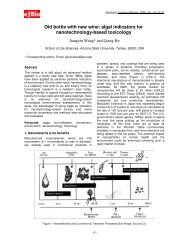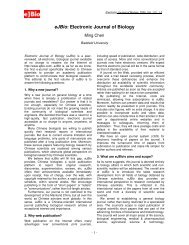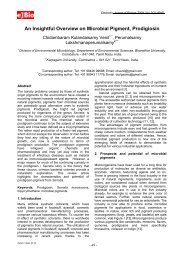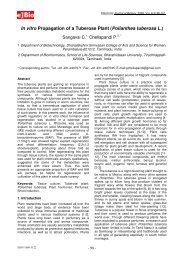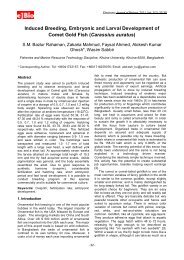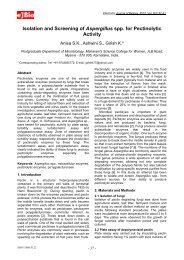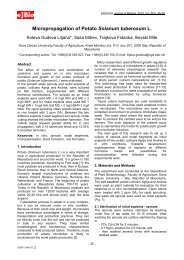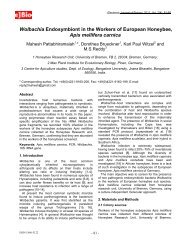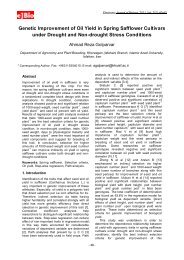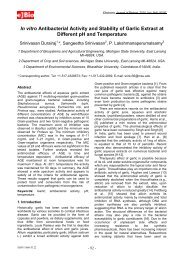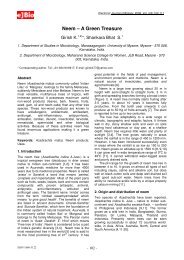Introns in Phylum Nemertea - Electronic Journal of Biology
Introns in Phylum Nemertea - Electronic Journal of Biology
Introns in Phylum Nemertea - Electronic Journal of Biology
You also want an ePaper? Increase the reach of your titles
YUMPU automatically turns print PDFs into web optimized ePapers that Google loves.
<strong>Electronic</strong> <strong>Journal</strong> <strong>of</strong> <strong>Biology</strong>, 2011, Vol. 7(3): 60-66<br />
<strong>Introns</strong> <strong>in</strong> <strong>Phylum</strong> <strong>Nemertea</strong><br />
James J. Youngblom*<br />
Dept. <strong>of</strong> Biological Sciences California State University, Stanislaus One University Circle Turlock, CA<br />
95382 USA.<br />
* Correspond<strong>in</strong>g author. Tel: +1-209-667-3950, Fax +1-209- 667-3694; jyoungblom@csustan.edu<br />
Abstract<br />
Ribbon worms are members <strong>of</strong> a taxonomic group<br />
(phylum <strong>Nemertea</strong>) for which little <strong>in</strong>formation<br />
regard<strong>in</strong>g gene structure is available. This study<br />
looked at <strong>in</strong>tron number, <strong>in</strong>tron length, <strong>in</strong>tron<br />
position, and <strong>in</strong>tron/exon junctions for the <strong>in</strong>trons <strong>of</strong><br />
eight genes from the milky ribbon worm,<br />
Cerebratulus lacteus. A total <strong>of</strong> 22 <strong>in</strong>trons were<br />
present <strong>in</strong> the eight genes, averag<strong>in</strong>g approximately<br />
1200 base pairs <strong>in</strong> length. All <strong>in</strong>tron/exon junctions<br />
conta<strong>in</strong>ed consensus splice site sequences. Intron<br />
placement <strong>in</strong> these eight nemertean genes was<br />
compared to <strong>in</strong>trons <strong>in</strong> homologous counterparts <strong>of</strong><br />
other species. There were numerous cases where<br />
an <strong>in</strong>tron from C. lacteus shared the same position<br />
and phase with <strong>in</strong>trons from homologous genes <strong>in</strong><br />
various other animals, <strong>in</strong>clud<strong>in</strong>g vertebrates.<br />
There was one case where an <strong>in</strong>tron from C.<br />
lacteus shared the same position and phase with<br />
<strong>in</strong>trons from homologous genes <strong>in</strong> an assortment <strong>of</strong><br />
organisms, <strong>in</strong>clud<strong>in</strong>g vertebrates,other <strong>in</strong>vertebrates,<br />
and higher plants.<br />
Research highlights:<br />
Eight genes <strong>in</strong> the nemertean C. lacteus conta<strong>in</strong> an<br />
average <strong>of</strong> 2.75 <strong>in</strong>trons<br />
Eight genes <strong>in</strong> C. lacteus have <strong>in</strong>trons with an<br />
average length <strong>of</strong> 1200 base pairs<br />
Twenty-two <strong>in</strong>trons <strong>in</strong> C. lacteus all conta<strong>in</strong><br />
consensus splice sites<br />
<strong>Nemertea</strong>n <strong>in</strong>tron position and phase are <strong>of</strong>ten<br />
found to be conserved across k<strong>in</strong>gdoms<br />
Keywords: Cerebratulus, <strong>in</strong>tron evolution, splice<br />
junctions, <strong>in</strong>tron placement, <strong>Nemertea</strong>.<br />
1. Introduction<br />
<strong>Nemertea</strong>ns, commonly called ribbon worms, are<br />
s<strong>of</strong>t-bodied, unsegmented, vermiform <strong>in</strong>vertebrates<br />
found worldwide [1, 2]. All are members <strong>of</strong> the<br />
same taxonomic group, phylum <strong>Nemertea</strong> [3]. They<br />
are protostome animals (lophotrochozoans) [4].<br />
Most ribbon worms are mar<strong>in</strong>e animals; a few<br />
species are located <strong>in</strong> fresh water or found on moist<br />
tropical land [5]. Ribbon worms are ma<strong>in</strong>ly<br />
carnivores or scavengers. All ribbon worms have a<br />
unique feature called a proboscis that can be quickly<br />
shot out <strong>of</strong> an anterior open<strong>in</strong>g near the mouth.The<br />
proboscis coils around and immobilizes prey.<br />
<strong>Nemertea</strong>ns range <strong>in</strong> length from less than one<br />
centimeter to greater than thirty meters [6]. The<br />
body <strong>of</strong> nemerteans is highly extensible and can<br />
extend many times its normal length [3]. They are a<br />
small animal group with around 1270 species<br />
named and described [7]. New species cont<strong>in</strong>ue to<br />
be described on a regular basis [8, 9]. This paper<br />
describes decipher<strong>in</strong>g genes <strong>of</strong> Cerebratulus<br />
lacteus- the milky ribbon worm. The nucleic acids<br />
analyzed <strong>in</strong> this paper were isolated from an<br />
organism collected <strong>of</strong>f the coast <strong>of</strong> New England.<br />
<strong>Introns</strong> are noncod<strong>in</strong>g sequences located with<strong>in</strong><br />
eukaryotic genes [10, 11,12,13].<strong>Introns</strong> are spliced<br />
out after gene transcription but before the mRNA<br />
leaves the nucleus for translation. Exons are the<br />
segments that rema<strong>in</strong> after splic<strong>in</strong>g. Exons and<br />
<strong>in</strong>trons alternate <strong>in</strong> the premature mRNA (premRNA).<br />
The spliceosome is the multi-subunit<br />
RNA/prote<strong>in</strong> complex that is required for the<br />
removal <strong>of</strong> <strong>in</strong>trons from most eukaryotic pre-mRNAs<br />
[14]. Spliceosomal <strong>in</strong>trons are the dom<strong>in</strong>ant type <strong>of</strong><br />
eukaryotic <strong>in</strong>tron and absent from prokaryotic<br />
organisms but present <strong>in</strong> all major eukaryotic<br />
l<strong>in</strong>eages [15, 16]. <strong>Introns</strong> numbers range from an<br />
average <strong>of</strong> ~ n<strong>in</strong>e <strong>in</strong>trons per gene <strong>in</strong> humans to<br />
less than one <strong>in</strong>tron per gene <strong>in</strong> many s<strong>in</strong>gle-celled<br />
eukaryotes [17].Certa<strong>in</strong> properties <strong>of</strong> <strong>in</strong>trons are<br />
undoubtedly liabilities- they require excess DNA and<br />
RNA synthesis and enhance the eukaryotic mutation<br />
rate <strong>in</strong> a number <strong>of</strong> different ways. On the other<br />
side, <strong>in</strong>trons may provide a mechanism for evolution<br />
<strong>of</strong> new prote<strong>in</strong>s and <strong>in</strong>crease the number <strong>of</strong> prote<strong>in</strong><br />
is<strong>of</strong>orms generated by a given gene through the use<br />
<strong>of</strong> alternative splic<strong>in</strong>g [18, 19].<br />
This paper looks specifically at <strong>in</strong>trons <strong>in</strong> eight C.<br />
lacteus genes- the first significant look at <strong>in</strong>tron<br />
structure and number <strong>in</strong> the phylum <strong>Nemertea</strong>. A<br />
recent search <strong>of</strong> Genbank nucleotides turned up<br />
<strong>in</strong>formation on only 4 <strong>in</strong>trons from 2 nemertean<br />
genes [20]. In this paper eight nemertean genes<br />
were analyzed <strong>in</strong>clud<strong>in</strong>g 22 new <strong>in</strong>trons. Intron<br />
placement <strong>in</strong> these nemertean genes was compared<br />
to <strong>in</strong>trons <strong>in</strong> homologous counterparts. When<br />
available, the homologous counterparts <strong>in</strong>cluded<br />
ISSN 1860-3122 - 60 -
<strong>Electronic</strong> <strong>Journal</strong> <strong>of</strong> <strong>Biology</strong>, 2011, Vol. 7(3): 60-66<br />
vertebrate and <strong>in</strong>vertebrate animals, higher plants,<br />
and a fungus.<br />
2. Materials and Methods<br />
2.1 cDNA clon<strong>in</strong>g and Analysis<br />
Live specimens <strong>of</strong> C. lacteus were obta<strong>in</strong>ed though<br />
the Aquatic Resources Division <strong>of</strong> the MBL (Mar<strong>in</strong>e<br />
Biological Laboratory, Woods Hole, MA). A whole<br />
nemertean worm cDNA library was constructed by<br />
Amplicon Express® (Pullman, WA). C. lacteus<br />
cDNAs were directionally cloned <strong>in</strong>to the EcoRI and<br />
XhoI sites <strong>of</strong> the plasmid vector pBluescript II SK(+)<br />
and propagated <strong>in</strong> E. coli. stra<strong>in</strong> DH10B. The library<br />
titer was 9.0 x 105 cfu/ml. The library was amplified<br />
and is stored at –80 C. Pure colonies were picked,<br />
grown, and cDNA conta<strong>in</strong><strong>in</strong>g plasmids isolated<br />
us<strong>in</strong>g Qiagen’s QIAprep ® Sp<strong>in</strong> M<strong>in</strong>iprep kit. The<br />
sizes <strong>of</strong> the plasmid cDNA <strong>in</strong>serts were determ<strong>in</strong>ed<br />
by restriction enzyme digests <strong>of</strong> the plasmid or by<br />
PCR amplification <strong>of</strong> the multiple clon<strong>in</strong>g site<br />
followed by agarose gel electrophoresis. Plasmid<br />
cDNAs <strong>in</strong>serts > 0.6 kb were chosen for further<br />
analysis. Purified plasmids and primers were sent<br />
to the sequenc<strong>in</strong>g center at San Diego State<br />
University (Microchemical Core Facility, San Diego,<br />
CA) or to the University <strong>of</strong> Nevada (Nevada<br />
Genomics Center, Reno, NV) for sequenc<strong>in</strong>g<br />
reactions and gel electrophoresis. The first<br />
sequenc<strong>in</strong>g pass on each strand was primed us<strong>in</strong>g<br />
pBluescript plasmid sequences adjacent to the<br />
clon<strong>in</strong>g site. Additional sequenc<strong>in</strong>g reactions were<br />
primed with <strong>in</strong>ternal primers developed us<strong>in</strong>g the<br />
primer design tool Primer 3 [21]. All cDNAs were<br />
sequenced end to end, both strands. Sequenc<strong>in</strong>g<br />
files were analyzed us<strong>in</strong>g the freeware package<br />
Chromas Lite (http://www.technelysium.com.au/<br />
chromas_lite.html) or F<strong>in</strong>ch TV<br />
(http://www.geospiza.com). DNA files were stored,<br />
analyzed, compared, and manipulated us<strong>in</strong>g the<br />
<strong>Biology</strong> Workbench (http://workbench.sdsc.edu),<br />
provided by the San Diego Supercomputer Center.<br />
2.2 Genomic DNA Isolation and Analysis<br />
C. lacteus genomic DNA was isolated from one<br />
adult <strong>in</strong>dividual. The specimen was sacrificed by<br />
immersion <strong>in</strong> 95% ethanol. Approximately 100 mg<br />
<strong>of</strong> lateral midbody was removed with a clean razor<br />
blade. The sample was frozen <strong>in</strong> liquid nitrogen and<br />
pulverized with mortar and pestle until the material<br />
resembled medium sized sand gra<strong>in</strong>s. A total <strong>of</strong> 35<br />
mg <strong>of</strong> the pulverized tissue was utilized for the DNA<br />
extraction. The DNA was extracted us<strong>in</strong>g the<br />
Tissue DNA Kit (E.Z.N.A. protocol for Tissue)<br />
purchased from Omega Bio-Tek, Inc., and 50<br />
micrograms <strong>of</strong> C. lacteus high molecular weight<br />
genomic DNA was recovered.<br />
Selected cDNAs were chosen for <strong>in</strong>tron analysis.<br />
Intron organization was <strong>in</strong>vestigated by design<strong>in</strong>g 4-<br />
8 staggered, overlapp<strong>in</strong>g primer pairs based on the<br />
cDNA sequence. The primer pairs were utilized to<br />
PCR amplify the cDNA fragment and a fragment <strong>of</strong><br />
C. lacteus genomic DNA. For each pair <strong>of</strong> primers,<br />
the PCR amplicons from the cDNA and genomic<br />
DNA were compared via 2% agarose gel<br />
electrophoresis (50 ml m<strong>in</strong>i-gels). Genomic DNA<br />
fragments were purified (QIAquick PCR Purification<br />
Kit, Qiagen, Inc.®) and submitted to the Nevada<br />
Genomics Center, Reno, NV for sequenc<strong>in</strong>g. The<br />
<strong>Biology</strong> Workbench (workbench.sdsc.edu) and the<br />
<strong>in</strong>teractive web tools from the National Center for<br />
Biotechnology Information (www.ncbi.nlm.nih.gov)<br />
were particularly useful for f<strong>in</strong>d<strong>in</strong>g homologous<br />
prote<strong>in</strong> and genomic DNA sequences. A prote<strong>in</strong><br />
multiple sequence alignment (ClustalW) was used to<br />
identify homologous am<strong>in</strong>o acids.<br />
3. Results and Discussion<br />
3.1 cDNA Identification<br />
Eight cDNAs from the nemertean Cerebratulus<br />
lacteus were deciphered. Each cDNA <strong>in</strong>cluded a<br />
long open read<strong>in</strong>g frame. The number <strong>of</strong> am<strong>in</strong>o<br />
acids ranged from 169 to 329 am<strong>in</strong>o acids. The<br />
cDNA was identified by us<strong>in</strong>g the predicted peptide<br />
sequence to search Swiss-Prot for homologous<br />
prote<strong>in</strong>s (Table 1).<br />
C.<br />
lacteus<br />
cDNA #<br />
#206<br />
#518<br />
#313<br />
#514<br />
#513<br />
#334<br />
#213<br />
Table 1 Identification <strong>of</strong> C. lacteus cDNAs.<br />
Best Match blastp<br />
(Swiss-Prot)<br />
Soma ferrit<strong>in</strong> - L.<br />
stagnalis (great pond<br />
snail)<br />
ATP synthase subunit<br />
d - D. melanogaster<br />
(fruit fly)<br />
Ependym<strong>in</strong>-related<br />
prote<strong>in</strong> 1 - M.<br />
musculus (mouse)<br />
Akir<strong>in</strong> from X. tropicalis<br />
- (western clawed frog)<br />
Ribosomal prote<strong>in</strong> L13<br />
- I. punctatus (catfish)<br />
Ribosomal prote<strong>in</strong> S6 -<br />
A. californica (sea<br />
hare)<br />
60S ribosomal prote<strong>in</strong><br />
P0 - C. capitata ( fruit<br />
fly)<br />
Cathesp<strong>in</strong> L - S.<br />
E<br />
value<br />
# am<strong>in</strong>o<br />
acids<br />
6e-61 169 aa<br />
4e-34 172 aa<br />
2e-25 187 aa<br />
9e-31 195 aa<br />
9e-76 207aa<br />
3e-<br />
115<br />
2e-<br />
117<br />
247 aa<br />
315 aa<br />
3e-<br />
#47<br />
329 aa<br />
peregr<strong>in</strong>e (flesh fly) 102<br />
Note: Open read<strong>in</strong>g frames were located by ‘six frame’<br />
(see workbench.sdsc.edu). Long open read<strong>in</strong>g frames<br />
were identified and del<strong>in</strong>eated after query<strong>in</strong>g the<br />
UniProtKB/Swiss-Prot prote<strong>in</strong> database us<strong>in</strong>g ‘blastp’ (see<br />
http://blast.ncbi.nlm.nih.gov/). The cDNA # is an arbitrary<br />
bookkeep<strong>in</strong>g number.<br />
3.2 Intron Analysis<br />
Us<strong>in</strong>g the cDNA sequence data, PCR primers were<br />
designed for genomic DNA amplification. <strong>Introns</strong><br />
ISSN 1860-3122 - 61 -
<strong>Electronic</strong> <strong>Journal</strong> <strong>of</strong> <strong>Biology</strong>, 2011, Vol. 7(3): 60-66<br />
were identified by compar<strong>in</strong>g genomic DNA<br />
amplicons to cDNA amplicons. The genomic DNA<br />
fragments were partially deciphered, <strong>in</strong>clud<strong>in</strong>g each<br />
<strong>in</strong>tron/exon junction to identify <strong>in</strong>trons (Table 2).<br />
Intron size ranged from ~400 bp to ~ 3000 bp. The<br />
average <strong>in</strong>tron number <strong>in</strong> these eight genes was<br />
2.75 <strong>in</strong>trons/gene. The number <strong>of</strong> <strong>in</strong>trons identified<br />
per gene ranged from 0 to 5. Twenty- two <strong>in</strong>trons<br />
were identified with an average length <strong>of</strong> ~ 1230 bp.<br />
AG splice acceptor (Figure 1). Other nucleotides<br />
around the splice site showed strong conservation.<br />
Table 2- <strong>Introns</strong> located <strong>in</strong> eight nemertean genes.<br />
cDNA # Intron # Length (bp)<br />
47 None NA<br />
206 1 ~1650<br />
2 ~1150<br />
334 1 ~3000<br />
2 ~700<br />
513 1 ~800<br />
2 ~1900<br />
514 1 ~1400<br />
2 ~500<br />
3 ~800<br />
313 1 ~750<br />
2 ~550<br />
3 ~550<br />
4 ~2100<br />
518 1 ~3000<br />
2 ~900<br />
3 ~400<br />
4 ~1450<br />
213 1 ~2100<br />
2 ~850<br />
3 ~450<br />
4 ~400<br />
5 ~1750<br />
Note: Intron lengths are <strong>in</strong> base pairs (bp) and numbered<br />
started from the 5’ end <strong>of</strong> each cDNA<br />
The <strong>in</strong>tron/exon splice junctions identified here<br />
conform to the typical eukaryotic splice sites. All<br />
<strong>in</strong>trons sequences had a 5’ GT splice donor and a 3’<br />
Figure 1. Consensus sequences for the splice junctions<br />
<strong>of</strong> 26 nemertean <strong>in</strong>trons. Shown <strong>in</strong> the top section are the<br />
consensus for the last nucleotide <strong>of</strong> the exons and the first<br />
6 nucleotides <strong>of</strong> the <strong>in</strong>trons. Shown <strong>in</strong> the lower section<br />
are the consensus for the last 6 nucleotides <strong>of</strong> the <strong>in</strong>trons<br />
and the first nucleotide <strong>of</strong> the exons. The bold l<strong>in</strong>es<br />
represent the exon/<strong>in</strong>tron junctions. Twenty-two <strong>of</strong> the<br />
<strong>in</strong>tron junctions were determ<strong>in</strong>ed by the author and four<br />
by Vandergon et al.<br />
An <strong>in</strong>vestigation <strong>of</strong> <strong>in</strong>tron positions was <strong>in</strong>itiated for<br />
these 8 nemertean genes. The position <strong>of</strong> the<br />
<strong>in</strong>trons <strong>in</strong> the C. lacteus genes was compared to the<br />
position <strong>of</strong> the <strong>in</strong>trons <strong>in</strong> homologous genes. A<br />
relevant comparison requires identification <strong>of</strong><br />
homologous genes. In addition when compar<strong>in</strong>g<br />
<strong>in</strong>tron positions <strong>in</strong> homologous genes, it is critical<br />
that homologous am<strong>in</strong>o acid codons can be<br />
identified. DNA and prote<strong>in</strong> sequences were<br />
available that allowed <strong>in</strong>tron positions to be<br />
contrasted between the four <strong>of</strong> the eight nemertean<br />
genes and <strong>in</strong>trons positions <strong>in</strong> the homologous<br />
genes for 2 vertebrates species, 2 <strong>in</strong>vertebrate<br />
species, 2 higher plant species, and a fungal<br />
species. For the other 4 nemertean genes there<br />
were vertebrate and <strong>in</strong>vertebrate homologous<br />
sequences available but no counterparts available<br />
for higher plants and/or fungus (Figure 2).<br />
Part 1<br />
ISSN 1860-3122 - 62 -
<strong>Electronic</strong> <strong>Journal</strong> <strong>of</strong> <strong>Biology</strong>, 2011, Vol. 7(3): 60-66<br />
Part 2<br />
Part3<br />
Part4<br />
Figure 2. Triangles represent <strong>in</strong>tron positions <strong>in</strong> 8 nemertean genes and homologous counterparts. The <strong>in</strong>tron is located<br />
immediately after the am<strong>in</strong>o acid <strong>in</strong>dicated <strong>in</strong> the column head<strong>in</strong>g. Whole numbers represent phase 0 <strong>in</strong>trons. Phase 1<br />
and phase 2 <strong>in</strong>trons are represented by xxx.1 or xxx.2, respectively. U represents the 5’ untranslated region. All<br />
numbers are relative to the am<strong>in</strong>o acid position <strong>in</strong> the C. lacteus version <strong>of</strong> the prote<strong>in</strong>. Common names <strong>of</strong> the<br />
organisms are as follows: H. sapiens = human, X. tropicalis = western clawed frog, D. melanogaster = fruit fly, C.<br />
elegans = nematode roundworm, C. lacteus = milky ribbon worm, A. thaliana = mouse-ear cress (flower<strong>in</strong>g plant), O.<br />
sativa = rice, S. purpuratus = sea urch<strong>in</strong>, D. rerio = zebra fish, S. kowalevskii = acorn worm, M. brevicollis =<br />
choan<strong>of</strong>lagellate, N. crassa = bread mold, E. <strong>in</strong>test<strong>in</strong>alis = fungal parasite (microsporidia). ? = <strong>in</strong>formation unavailable.<br />
ISSN 1860-3122 - 63 -
<strong>Electronic</strong> <strong>Journal</strong> <strong>of</strong> <strong>Biology</strong>, 2011, Vol. 7(3): 60-66<br />
S<strong>in</strong>ce the discovery <strong>of</strong> <strong>in</strong>trons <strong>in</strong> the late 1970s,<br />
biologists have theorized on the orig<strong>in</strong> <strong>of</strong> spliced<br />
genes[22, 23, 24, 25]. It is agreed that there is a<br />
strong but imperfect correlation between <strong>in</strong>tron size<br />
and <strong>in</strong>tron number with eukaryotic complexitygenerally<br />
the more complex the organism, the<br />
longer and more numerous the <strong>in</strong>trons [26]. When<br />
asked to expla<strong>in</strong> this correlation, there is much<br />
disagreement. Two dichotomous theories<br />
dom<strong>in</strong>ated the <strong>in</strong>itial debates: <strong>in</strong>trons-early [27] and<br />
<strong>in</strong>trons-late [28].Proponents <strong>of</strong> <strong>in</strong>trons-early (also<br />
called the exon theory <strong>of</strong> genes) argue that the<br />
earliest genes (before the evolution <strong>of</strong> eukaryotic<br />
organisms) had <strong>in</strong>trons and that they played a<br />
pivotal role <strong>in</strong> gene evolution [29, 30, 31]. In this<br />
view early genes evolved <strong>in</strong>to more complex genes<br />
as small exons were recomb<strong>in</strong>ed <strong>in</strong>to larger<br />
multiexon units. In <strong>in</strong>trons-early, bacteria have no<br />
<strong>in</strong>trons today as they have slimmed down their<br />
genomes and lost their <strong>in</strong>trons over the eons. The<br />
debate shifted subtly with the discovery that there<br />
are different types <strong>of</strong> <strong>in</strong>trons [32, 33, 34, 35].<br />
Bacteria have the simpler self-splic<strong>in</strong>g <strong>in</strong>trons but<br />
lack spliceosomal <strong>in</strong>trons. Debates regard<strong>in</strong>g <strong>in</strong>tron<br />
evolution are predom<strong>in</strong>antly revolv<strong>in</strong>g around the<br />
evolution <strong>of</strong> spliceosomal <strong>in</strong>trons and the<br />
spliceosome [36]. To some, the lack <strong>of</strong> a s<strong>in</strong>gle<br />
spliceosomal <strong>in</strong>tron <strong>in</strong> any prokaryotic genome<br />
despite thousands deciphered <strong>in</strong>dicates that<br />
bacteria never had complex <strong>in</strong>trons- hence the<br />
emergence <strong>of</strong> a contrast<strong>in</strong>g theory, <strong>in</strong>trons-late. In<br />
<strong>in</strong>trons late, bacteria never had spliceosomal<br />
<strong>in</strong>trons[37, 38]. In this view, spliceosomal <strong>in</strong>trons<br />
evolved along with eukaryotic complexity. Most<br />
proponents <strong>of</strong> <strong>in</strong>trons-late argue that <strong>in</strong>trons played<br />
no positive role <strong>in</strong> eukaryotic evolution but are<br />
parasitic segments <strong>of</strong> DNA that progressively<br />
<strong>in</strong>vaded eukaryotic genomes. In this view the<br />
predom<strong>in</strong>ant evolutionary activity is not <strong>in</strong>tron loss,<br />
but <strong>in</strong>tron ga<strong>in</strong>. Proponents <strong>of</strong> <strong>in</strong>trons-late have<br />
declared that as additional genes have been<br />
deciphered and more <strong>in</strong>trons and <strong>in</strong>tron placements<br />
discovered, <strong>in</strong>tron evolution without <strong>in</strong>tron ga<strong>in</strong><br />
seems unlikely. With only <strong>in</strong>tron losses to account<br />
for the observed <strong>in</strong>trons, the number <strong>of</strong> <strong>in</strong>terruptions<br />
<strong>in</strong> the ancestral gene needs to be unreasonably<br />
high.<br />
As more and more complete genomes are<br />
deciphered, the <strong>in</strong>tron debate is shift<strong>in</strong>g. There is<br />
general agreement that <strong>in</strong>trons were present <strong>in</strong> the<br />
earliest eukaryotic (or pre-eukaryotic) organisms.<br />
The burgeon<strong>in</strong>g field <strong>of</strong> comparative genomics has<br />
resulted <strong>in</strong> numerous publications hypothesiz<strong>in</strong>g<br />
<strong>in</strong>tron loss and <strong>in</strong>tron ga<strong>in</strong> as factors determ<strong>in</strong><strong>in</strong>g<br />
current eukaryotic <strong>in</strong>tron placement and number [39,<br />
40]. The predicted rates vary considerable across<br />
eukaryotic taxa [41]. There is particularly strong<br />
evidence to support recent <strong>in</strong>tron ga<strong>in</strong>s <strong>in</strong> various<br />
organisms and gene families.<br />
4. Conclusions<br />
Despite progress <strong>in</strong> uncover<strong>in</strong>g the dynamic nature<br />
<strong>of</strong> <strong>in</strong>trons, there is still much to explore. The<br />
structure <strong>of</strong> ancestral genes is unknown. Hence<br />
one can only use analysis <strong>of</strong> modern genes to make<br />
<strong>in</strong>ference regard<strong>in</strong>g the evolution <strong>of</strong> eukaryotic<br />
genes. The structure <strong>of</strong> <strong>in</strong>trons <strong>in</strong> the phylum<br />
<strong>Nemertea</strong> is unknown. This paper presents a first<br />
detailed analysis <strong>of</strong> <strong>in</strong>trons <strong>in</strong> phylum <strong>Nemertea</strong>.<br />
The <strong>in</strong>trons discovered here ranged <strong>in</strong> size from<br />
~400 to ~3000 bp for the twenty-two <strong>in</strong>trons present<br />
<strong>in</strong> eight genes (average 2.75 <strong>in</strong>trons per gene).<br />
Neither the <strong>in</strong>tron size or <strong>in</strong>tron number is unusual<br />
for an <strong>in</strong>vertebrate organism [42,43] The analysis <strong>of</strong><br />
<strong>in</strong>trons from genes with deciphered homologous<br />
counterparts permitted cross k<strong>in</strong>gdom analysis <strong>of</strong><br />
<strong>in</strong>tron placement. As revealed here, the structure <strong>of</strong><br />
<strong>in</strong>trons <strong>in</strong> the nemertean C. lacteus conforms to the<br />
same <strong>in</strong>tron structure found <strong>in</strong> most other eukaryotic<br />
genes, suggest<strong>in</strong>g that these <strong>in</strong>trons undergo<br />
canonical splic<strong>in</strong>g. The placement <strong>of</strong> <strong>in</strong>trons <strong>in</strong><br />
genes <strong>of</strong> C. lacteus reveal homologous <strong>in</strong>tron<br />
placement (same am<strong>in</strong>o acid, same phase) across<br />
various taxonomic k<strong>in</strong>gdoms. How can this be<br />
expla<strong>in</strong>ed? Most <strong>in</strong>tron biologists take this, and<br />
other similar analyses, as evidence for spliceosomal<br />
<strong>in</strong>trons <strong>in</strong> the common ancestor <strong>of</strong> eukaryotic<br />
organisms. Coupled with the modern-day evidence<br />
for recent <strong>in</strong>tron losses and ga<strong>in</strong>s, neither <strong>of</strong> the<br />
dom<strong>in</strong>eer<strong>in</strong>g hypotheses (<strong>in</strong>trons-early or <strong>in</strong>tronslate)<br />
is likely to be substantiated. If <strong>in</strong>trons were<br />
present <strong>in</strong> the last common ancestor <strong>of</strong> prokaryotic<br />
and eukaryotic cells and have been jump<strong>in</strong>g <strong>in</strong>to<br />
and out <strong>of</strong> eukaryotic l<strong>in</strong>eages, <strong>in</strong>trons-cont<strong>in</strong>ual is<br />
the more accurate description.<br />
Acknowledgements<br />
This work was funded by RSCA, California State<br />
University, Stanislaus (USA) and BRC <strong>of</strong> the Dept.<br />
<strong>of</strong> Biological Sciences, California State University<br />
(USA). Numerous undergraduates research<br />
assistants participated <strong>in</strong> the generat<strong>in</strong>g <strong>of</strong> the data,<br />
particularly Alyssa Cifelli, Ahmad Eltejaye, Stephen<br />
Jacobs, Austen Jelcick, Peter L<strong>in</strong>dbeck, Nelson<br />
Membreno, Denisse Monroy, Jennifer Morotti,<br />
Nicole Reeves, Craig Speilman, Brian Stubblefield,<br />
and Sarah Tait.<br />
References<br />
[1] Gibson, R. (1995). <strong>Nemertea</strong>n species and genera<br />
<strong>of</strong> the world: an annotated check-list <strong>of</strong> orig<strong>in</strong>al<br />
names and description citations, synonyms, current<br />
taxonomic status, habitats and recorded<br />
zoogeographic distribution. J. Nat. Hist. 29, 271–562.<br />
[2] Turbeville, J.M. (2002). Progress <strong>in</strong> <strong>Nemertea</strong>n<br />
<strong>Biology</strong>: Development and Phylogeny. Integr. Comp.<br />
Biol. 42, 692-703.<br />
ISSN 1860-3122 - 64 -
<strong>Electronic</strong> <strong>Journal</strong> <strong>of</strong> <strong>Biology</strong>, 2011, Vol. 7(3): 60-66<br />
[3] Thollesson, M., Norenburg, J.L. (2003). Ribbon<br />
worm relationships: a phylogeny <strong>of</strong> the phylum<br />
<strong>Nemertea</strong>. Proc. Biol. Sci. 270, 407-415.<br />
[4] Turbeville, J.M. (1986). An ultrastructural analysis <strong>of</strong><br />
coelomogenesis <strong>in</strong> the Hoplonemert<strong>in</strong>e<br />
Prosorhochmus americanus and the Polychaete<br />
Magelona sp. J. Morphol. 187, 51–60.<br />
[5] Brusca, R.C., Brusca, G.J. (2003). Invertebrates<br />
(3rd ed.) S<strong>in</strong>auer Associates, Inc. Sunderland,<br />
Mass., USA.<br />
[6] Turbeville, J.M. (1996). Nemert<strong>in</strong>i, Schnurwürmer.<br />
In Spezielle Zoologie—Teil 1: E<strong>in</strong>zeller und<br />
Wirbellose Tiere (Westheide W., Rieger R.M.,<br />
editors). Gustav Fischer Verlag, Stuttgart (Germany).<br />
pp. 265-275.<br />
[7] Kajihara H., Chernychev A.V., Sichun S., Sundberg<br />
P., Crandall F. (2008). Checklist <strong>of</strong> nemertean<br />
generea and species (<strong>Nemertea</strong>) published between<br />
1995 and 2007. Spec. Div. 13: 245-274.<br />
[8] Costello, M.J., Wilson, S.P. (2011). Predict<strong>in</strong>g the<br />
number <strong>of</strong> known and unknown species <strong>in</strong> European<br />
seas us<strong>in</strong>g rates <strong>of</strong> description. Glob. Ecol. and<br />
Biogeogr. 20, 319-330.<br />
[9] Sundberg, P., Strand, M. (2010). <strong>Nemertea</strong>n<br />
taxonomy - time to change lane? J. Zool. Syst. Evol.<br />
Res. 48: 283-284.<br />
[10] Berget, S.M., Moore, C., Sharp, P.A. (1977).<br />
Spliced segments at the 5' term<strong>in</strong>us <strong>of</strong> adenovirus 2<br />
late mRNA. Proc. Natl. Acad. Sci. USA 74, 3171–<br />
3175.<br />
[11] Chow, L.T., Gel<strong>in</strong>as, R.E., Broker, T.R., Roberts, R.J.<br />
(1977). An amaz<strong>in</strong>g sequence arrangement at the<br />
5’ ends <strong>of</strong> adenovirus 2 messenger RNA. Cell 12, 1–<br />
8.<br />
[12] Evans, R.M., Fraser, N., Ziff, E., Weber, J., Wilson,<br />
M., Darnell, J.E. (1977). The <strong>in</strong>itiation sites for RNA<br />
transcription <strong>in</strong> Ad2 DNA. Cell 12, 733-739.<br />
[13] Goldberg, S., Schwartz, H., Darnell, J. E. (1977).<br />
Proc. Natl. Acad. Sci. USA 74, 4520−4523.<br />
[14] Nilsen, T. (2003). The spliceosome: the most<br />
complex macromolecular mach<strong>in</strong>e <strong>in</strong> the cell?.<br />
Bioessays 25, 1147–9.<br />
[15] Coll<strong>in</strong>s, L., Penny, D. (2005). Complex Spliceosomal<br />
Organization Ancestral to Extant Eukaryotes. Mol.<br />
Biol. Evol. 2, 1053-1066.<br />
[16] Nixon, J.E.J. , Wang, A., Morrison, H.G. , McArthur,<br />
A.G., Sog<strong>in</strong>, M.L., L<strong>of</strong>tus, B.J., Samuelson, J.<br />
(2002). Proc. Natl. Acad. Sci. USA 99, 3701-3705.<br />
[17] Logsdon, J.M. Jr, Stoltzfus, A., Doolittle, W.F.<br />
(1998b). Molecular evolution: recent cases <strong>of</strong><br />
spliceosomal <strong>in</strong>tron ga<strong>in</strong>? Curr. Biol. 8, R560-R563.<br />
[18] Black, D.L. (2003). Mechanisms <strong>of</strong> alternative premessenger<br />
RNA splic<strong>in</strong>g. Annu. Rev. Biochem. 72,<br />
291–336.<br />
[19] Gilbert, W. (1985). Genes-<strong>in</strong>-pieces revisited.<br />
Science 228, 823-4.<br />
[20] Vandergon, T.L., Riggs, C.K., Gorr, T.A., Colac<strong>in</strong>o,<br />
J.M. and Riggs, A.F. (1998). The m<strong>in</strong>i-hemoglob<strong>in</strong>s<br />
<strong>in</strong> neural and body wall tissue <strong>of</strong> the nemertean<br />
worm, Cerebratulus lacteus. J. Biol. Chem. 273,<br />
16998-17011.<br />
[21] Rozen,S., Skaletsky,H. (2000). Primer3 on the<br />
WWW for general users and for biologist<br />
programmers. Methods Mol. Biol. 132, 365–386.<br />
[22] Jeffares, D.C., Mourier, T. , Penny, D. (2006). The<br />
biology <strong>of</strong> <strong>in</strong>tron ga<strong>in</strong> and loss. Trends Genet. 22,<br />
16-22.<br />
[23] Lynch, M. (2002). Intron evolution as a populationgenetic<br />
process. Proc. Natl. Acad. Sci. USA 99,<br />
6118-6123<br />
[24] Roy, S.W., Gilbert, W. (2006). The evolution <strong>of</strong><br />
spliceosomal <strong>in</strong>trons: patterns, puzzles and progress.<br />
Nature Rev. Genet. 7, 211-221.<br />
[25] Simpson, A.G. B., MacQuarrie, E.K., Roger, A.J.<br />
(2002). Eukaryotic evolution: Early orig<strong>in</strong> <strong>of</strong><br />
canonical <strong>in</strong>trons. Nature 419, 270.<br />
[26] Lynch, M., Conery, J.S. (2003). The Orig<strong>in</strong>s <strong>of</strong><br />
Genome Complexity. Science 302, 1401-1404.<br />
[27] Gilbert, W., Glynias, M. (1993). On the ancient<br />
nature <strong>of</strong> <strong>in</strong>trons. Gene 135, 137-144.<br />
[28] Logsdon, J.M., Jr. (1998a). The recent orig<strong>in</strong>s <strong>of</strong><br />
spliceosomal <strong>in</strong>trons revisited. Curr. Op<strong>in</strong>. Genet.<br />
Dev. 8, 637–648.<br />
[29] Darnell, J.E. Jr. (1978). Implications <strong>of</strong> RNA-RNA<br />
splic<strong>in</strong>g <strong>in</strong> evolution <strong>of</strong> eukaryotic cells. Science 202,<br />
1257–1260.<br />
[30] Doolittle, W.F. (1978). Genes <strong>in</strong> pieces: were they<br />
ever together? Nature 272, 581–582.<br />
[31] Gilbert, W. (1978). Why genes <strong>in</strong> pieces? Nature 271:<br />
501.<br />
[32] Brody, E., Abelson, J. (1985). The "spliceosome":<br />
yeast pre-messenger RNA associates with a 40S<br />
complex <strong>in</strong> a splic<strong>in</strong>g dependent reaction. Science<br />
228, 963-967.<br />
[33] Cech, T.R. (1990). Self-splic<strong>in</strong>g <strong>of</strong> group I <strong>in</strong>trons.<br />
Annu. Rev. Biochem. 59, 543–68.<br />
[34] Frendewey, D., Keller, W. (1985). Stepwise<br />
assembly <strong>of</strong> a pre-mRNA splic<strong>in</strong>g complex requires<br />
U-snRNPs and specific <strong>in</strong>tron sequences. Cell 42,<br />
355-367.<br />
[35] Grabowski, P. J., Seiler, S. R., Sharp, P.A. (1985). A<br />
multicomponent complex is <strong>in</strong>volved <strong>in</strong> the splic<strong>in</strong>g <strong>of</strong><br />
messenger RNA precursors. Cell 42, 345-353.<br />
[36] Ahmad<strong>in</strong>ejad, N., Dagan, T., Gruenheit, N., Mart<strong>in</strong>,<br />
W., Gabaldón, T. (2010). Evolution <strong>of</strong> spliceosomal<br />
<strong>in</strong>trons follow<strong>in</strong>g endosymbiotic gene transfer. BMC<br />
Evol. Biol. 10, 57-67.<br />
[37] Palmer, J.D., Logsdon, J.M. Jr. (1991). The recent<br />
orig<strong>in</strong>s <strong>of</strong> <strong>in</strong>trons. Curr. Op<strong>in</strong>. Genet. Dev. 1, 470–<br />
477.<br />
[38] Cavalier-Smith, T. (1991). Intron phylogeny: a new<br />
hypothesis. Trends Genet. 7, 145–148.<br />
[39] Rogoz<strong>in</strong>, I.B., Wolf, Y.I., Sorok<strong>in</strong>, A.V., Mirk<strong>in</strong>, B.G.,<br />
Koon<strong>in</strong>, E.V. (2003). Remarkable <strong>in</strong>terk<strong>in</strong>gdom<br />
conservation <strong>of</strong> <strong>in</strong>tron positions and massive,<br />
ISSN 1860-3122 - 65 -
<strong>Electronic</strong> <strong>Journal</strong> <strong>of</strong> <strong>Biology</strong>, 2011, Vol. 7(3): 60-66<br />
l<strong>in</strong>eage-specific <strong>in</strong>tron loss and ga<strong>in</strong> <strong>in</strong> eukaryotic<br />
evolution. Curr. Biol. 13, 1512-1517.<br />
[40] Stajich, J.E., Dietrich, F.S., Roy, S.W. (2007).<br />
Comparative genomic analysis <strong>of</strong> fungal genomes<br />
reveals <strong>in</strong>tron-rich ancestors. Genome Biol. 8, R223.<br />
[41] Roy, S.W., Gilbert, W. (2005). Rates <strong>of</strong> <strong>in</strong>tron loss<br />
and ga<strong>in</strong>: implications for early eukaryotic evolution.<br />
Proc. Natl. Acad. Sci. USA 102, 5773-5778.<br />
[42] Colbourne, J.K., Pfrender, M.E., Gilbert, D., Thomas,<br />
W.K., Tucker, A., Oakley, T.H., Tokishita, S., Aerts,<br />
A., Arnold, G.J., Basu, M.K., Bauer, D.J., Cáceres,<br />
C.E., Carmel, L., Casola, C., Choi, J., Detter, J.C.,<br />
Dong, Q., Dusheyko, S., Eads, B.D., Fröhlich, T.,<br />
Geiler-Samerotte, K.A., Gerlach, D., Hatcher, P.,<br />
Jogdeo, S., Krijgsveld, J., Kriventseva, E.V., Kültz,<br />
D., Laforsch, C., L<strong>in</strong>dquist, E., Lopez, J., Manak,<br />
J.R., Muller, J., Pangil<strong>in</strong>an, J., Patwardhan, R.P.,<br />
Pitluck, S., Pritham, E.J., Rechtste<strong>in</strong>er, A., Rho, M.,<br />
Rogoz<strong>in</strong>, I.B., Sakarya, O., Salamov, A., Schaack, S.,<br />
Shapiro, Shiga,H., Y., Skalitzky, C., Smith, Z.,<br />
Souvorov, A., Sung, W., Tang, Z., Tsuchiya, D., Tu,<br />
H., Vos, H., Wang, M., Wolf, Y.I., Yamagata, H.,<br />
Yamada, T., Ye, Y., Shaw, J.R., Andrews, J.,<br />
Crease, T.J., Tang, H., Lucas, S.M., Robertson, H.R.,<br />
Bork,P., Koon<strong>in</strong>, E.V., Zdobnov, E.V., Grigoriev, I.V.,<br />
Lynch, M., Boore, J.L. (2011). The Ecoresponsive<br />
Genome <strong>of</strong> Daphnia pulex. Science 331, 555-561.<br />
[43] Koon<strong>in</strong>, E. (2009). Intron-Dom<strong>in</strong>ated Genomes <strong>of</strong><br />
Early Ancestors <strong>of</strong> Eukaryotes. J. Hered. 100, 618-<br />
623.<br />
.<br />
ISSN 1860-3122 - 66 -



